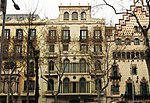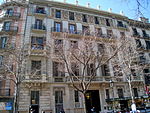Mandarin Oriental, Barcelona
Hotels in BarcelonaMandarin Oriental Hotel GroupMichelin Guide starred restaurants in Spain

Mandarin Oriental, Barcelona is a hotel located on Passeig de Gràcia in Barcelona, Spain. The Mandarin Oriental, Barcelona opened in November 2009 and was designed by a team of Spanish architects and designers: Carlos Ferrater and Joan Trias de Bes (architecture) and Patricia Urquiola (interior design). The hotel's 98 guest rooms and suites are housed in a re-developed, mid-20th Century building that was once home to a bank. Mandarin Oriental, Barcelona also includes The Spa at Mandarin Oriental, Barcelona and five restaurants and bars, including Moments, a Catalan restaurant headed up by Carme Ruscalleda, a Michelin-starred chef.
Excerpt from the Wikipedia article Mandarin Oriental, Barcelona (License: CC BY-SA 3.0, Authors, Images).Mandarin Oriental, Barcelona
Carrer del Consell de Cent, Barcelona
Geographical coordinates (GPS) Address Nearby Places Show on map
Geographical coordinates (GPS)
| Latitude | Longitude |
|---|---|
| N 41.391361111111 ° | E 2.1668888888889 ° |
Address
Mimosa
Carrer del Consell de Cent
08001 Barcelona
Catalonia, Spain
Open on Google Maps









